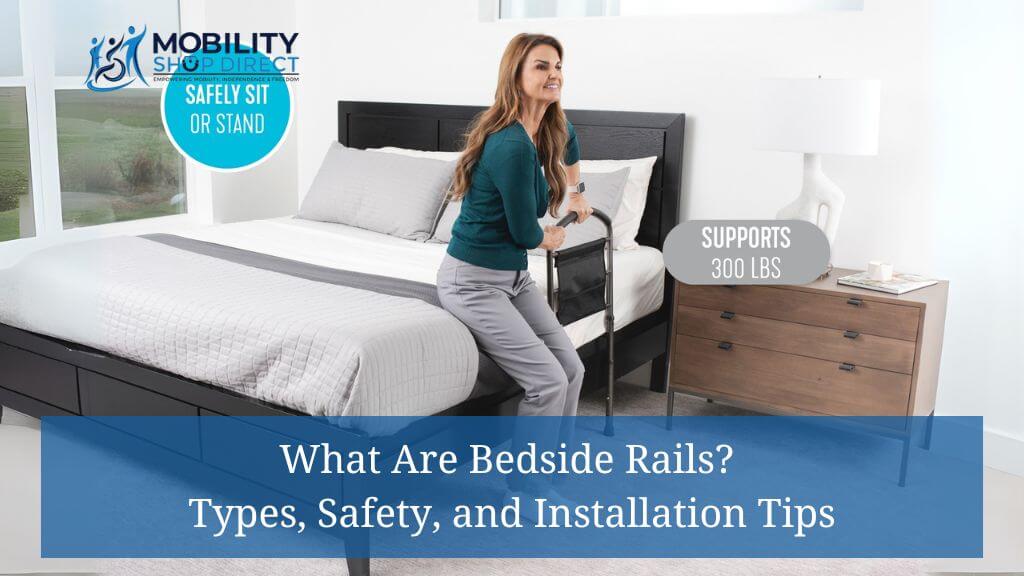If you’ve heard of bedside rails but aren’t quite sure what they are or whether they’re right for you or a loved one, you’re not alone. These simple yet effective mobility aids can play a big role in fall prevention, stability, and confidence, especially for older adults or people recovering from illness or surgery.
But what exactly do bedside rails do? What types are available? And how do you know if they’re compatible with your bed setup?
This guide covers the essentials: what bedside rails are, how they work, the different types on the market, key safety features, and tips for choosing and installing the right one. Whether you’re considering a full-length rail, a compact portable option, or something for a hospital-style bed, you’ll find the answers here to help you make a safe and confident choice.
Let’s dive in.
Table of Contents
- What Are Bedside Rails? Purpose and Essential Benefits
- Exploring the Types of Bedside Rails
- Bedside Rail Compatibility: Choosing the Right Match for Your Bed
- Bedside Rail Safety Features: What to Look For
- Installation Tips for Bedside Rails
- Key Takeaways
- Conclusion
What Are Bedside Rails? Purpose and Essential Benefits
What Is the Purpose of Bedside Rails?
Bedside rails attach to the side of a bed and help with both safety and movement. They prevent falls and give users a steady surface to grip when sitting up or getting in and out of bed. This makes a big difference for seniors, people recovering from surgery, or anyone with mobility issues.
They also make life easier for caregivers by reducing the need for physical lifting during daily tasks. In short, they offer support, stability, and peace of mind on both sides.
How Do Bedside Rails Prevent Falls and Improve Safety?
Falls are a major cause of injury, especially among older adults. Bedside rails act as physical barriers and offer stability for small movements, like reaching for something or turning in bed, that might otherwise lead to a fall.
Many models include locking systems and adjustable heights to fit the user’s specific needs. If you're a caregiver, the added peace of mind knowing your loved one is less likely to fall is hard to beat.
Bedside Rails vs. Side Rails: Key Differences Explained
The terms get mixed up, but there’s a difference. Bedside rails are smaller, usually portable, and made for home use. They’re good for everyday support and independence.
Side rails, on the other hand, are built into hospital beds. They’re usually longer and offer full containment, which is ideal for medical situations but can be limiting in home environments.
For home use, bedside rails tend to be more practical and flexible. This breakdown of different types can help you pick the right fit for your situation.
Exploring the Types of Bedside Rails
Full-Length Bedside Rails: Maximum Safety and Support
These rails run along most or all of the bed’s side, making them great for people at higher risk of falling out of bed. They’re a solid option for larger beds and work well with adjustable bases.
Just know that getting in and out of bed may take more effort with full-length rails in place. For more detail, check out this guide on choosing safe and adjustable rails.
Half-Length Bedside Rails: Flexible Support Options
Half-length rails offer protection without getting in the way. They’re usually placed near the head of the bed and are great for people who want support but also need easy access for getting up or moving around.
Portable Bedside Rails: Convenient and Travel-Friendly Options
Portable rails are lightweight and easy to set up, take down, or move. Perfect if you’re staying somewhere short-term or need to move the rail between locations. Most can be installed without tools, making them a great low-effort option.
Hospital Bed Rails: Specialized Safety for Medical Needs
These are built for people with serious health conditions and come with features like full-length coverage, built-in controls, and strong locking systems. They’re less about flexibility and more about meeting medical safety standards.
Bedside Rail Compatibility: Choosing the Right Match for Your Bed
Can Any Bed Rail Be Fitted to Any Bed?
No, and that’s a common mistake. The rail needs to match your bed's frame type, mattress size, and height. Adjustable beds often need special rails, and platform beds may need low-profile models.
Here’s a detailed guide to help you check if a rail is a good match for your bed setup.
How to Check Bed Rail Compatibility Before Buying
- Measure your mattress and frame, especially height and thickness
- Check the product’s listed specs to see if it's compatible
- See what other buyers with similar beds say in reviews
And make sure the attachment method, like clamps or slide-ins, actually works with your bed type.
Bedside Rail Safety Features: What to Look For
Key Safety Features That Prevent Falls and Injuries
- Non-slip grips for better control, even at night
- Strong locking mechanisms to hold everything in place
- Gap-free designs that reduce the risk of getting stuck
- Adjustable height options
Look for rails that help, not hinder. The right design should reduce fall risk without creating new problems.
Safety Considerations for Elderly or Limited Mobility Users
For older adults, prioritize rails that are easy to grip, securely mounted, and gentle on the skin. Smooth edges, extra padding, and easy-to-reach positioning go a long way. You’ll also want something with a secure base that won’t shift or wobble with movement.
Installation Tips for Bedside Rails
Proper Bed Rail Installation: A Step-by-Step Guide
- Read the manual (don’t skip this)
- Place the base under the mattress or attach it to the frame
- Secure any clamps, straps, or bolts
- Test for stability before regular use
Common Installation Pitfalls and How to Avoid Them
- Skipping compatibility checks before purchase
- Leaving screws or straps loose
- Placing the rail where the user can’t comfortably reach it
It’s worth taking a few extra minutes to get it right. Here’s more on picking and setting up the right rail.
Key Takeaways
- Bedside rails help prevent falls and assist with movement
- There are several types—each with pros and cons
- Check compatibility with your bed before buying
- Look for safety features like secure locks and padded grips
- Follow install instructions carefully to make sure it works properly
Conclusion
Bedside rails aren’t one-size-fits-all, but the right one can seriously improve safety and ease of movement. Whether you’re caring for someone or looking for a bit more independence at home, there’s a rail that fits.
Start by choosing from trusted bedside rail options here and make sure it suits your bed and your needs. A safe setup doesn’t just support your body, it supports your peace of mind too.



